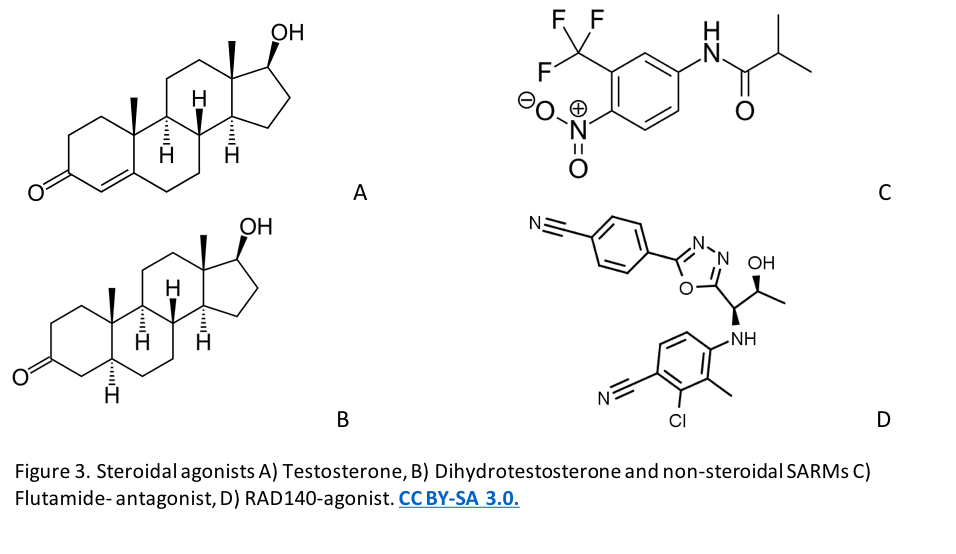Imagine a world in which humans can possess the power of a silver back gorilla, an Ox, or better yet, one of Prince George’s very own enormous salmon valley grizzly bears. Many humans have been close to this achievement, a great example being the male and female Olympic bodybuilders and weightlifters (figure1). Sadly, many of those who set out on this quest require the aid of ‘artificial assistance’ often abusing steroids extracted from living animals or synthesized in a lab. No matter how hard they may try to hide their usage, the side effects of using anabolic androgenic steroids (AAS) often reveals its consumer. Common side effects often include, but are not limited to: severe acne, oily skin and hair, hair loss, altered mood, irritability, depression, and increased aggression. Who are we to judge? If you want something bad enough who’s allowed to tell you otherwise? Even if it clearly comes at a cost…
The effects of steroid abuse are caused by attempting to ‘hijack’ the androgenic receptor (AR), a nuclear receptor protein, that’s loci are located on the X-chromosome in the species Homo sapiens (figure 2). Also referred to as a steroid receptor, the inactive AR exists in in the cytoplasm as a monomeric protein associated with heat shock proteins (HSP). Upon binding of an agonist ligand [ie; testosterone, dihydrotestosterone] to the AR’s ligand binding domain (LBD) a conformational change occurs. You can imagine as this protein undergoes transformation, bulging and twisting, as it is dissociating from the HSPs becoming a dynamic protein with one goal; to effectively facilitate transcription of androgenic genes. To do this, the activated AR is transported into the nucleus where it homodimerizes, followed by binding to androgenic response elements (ARE) located on DNA (figure 2). Here it will recruit additional transcription machinery such as the TATA-box-binding protein (TBP) and other co-activators before commencing transcription. The gene products include proteins involved in male sexual characteristics, cell proliferation, bone density and more!
Recently scientists have been working on developing and studying small molecules which bind the AR and generate selective transcription of androgenic genes. These molecules have been coined Selective Androgen Receptor Modulators or SARMs for short. These molecules often do not take the shape of the common 5-ring-carbon steroidal structure. Instead, they often contain an aromatic ring, with multiple substituents, frequently replacing hydrogen atoms with fluorine atoms to modify the electronics of the molecule. It is these fascinating and beautiful structures which have been shown to ‘selectively modulate’ the AR. This is done by either inducing the transcription of very select androgenic genes, selectively inhibiting transcription or inhibiting AR activation all together. Amazingly, these compounds don’t always compete for the LBD, instead they are able to bind other areas of the AR. Due to these alternate binding sites and unique structures of SARMs, scientists believe conformational changes induced by SARMs cause the AR to selectively recruit specific co-activator proteins which facilitate the transcription of specific AR genes! It has been shown that some of these agonistic SARMs such as RAD140 (figure3C) are able to induce the transcription of anabolic genes related to cell proliferation (smooth muscle growth), increased in bone density while negating androgenic gene transcription relating to specific male-sex characteristics at a ratio of 90:1!
Besides there use in Olympic body building, SARMs may one day be an effective treatment for increasing bone density in women with osteoporosis, burn victims and those with muscular damage, as well as treating hormone imbalances and other AR related diseases! SARMs are currently being developed with AR antagonistic properties to help treat prostate cancer and diseases involved in the alterations in the AR such as Flutamide (figure3D)! A world with SARMs is a fascinating and exciting one, filled with possibilities of creating a better environment and lifestyle for those living in discomfort. I hope after reading this that you too may share my excitement for SARMs and their unique properties!




Recent Comments